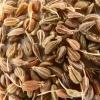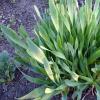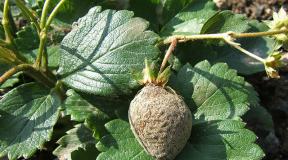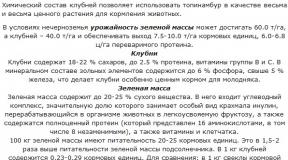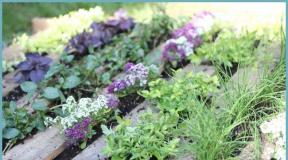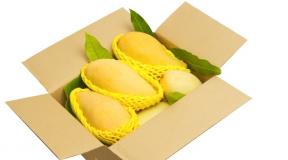Sowing oats: photo, description, medicinal properties. Sowing oats
Sowing oats
 Name: Sowing oats.
Name: Sowing oats.
Latin name: Avena sativa L.
Family: Poaceae
Life span: Annual.
Type of plant: Herbaceous plant.
Trunk (stem): The stem (straw) is erect, furrowed, smooth, with pronounced internodes, branches in the lower part - the branching node.
Height: 60-100 cm.
Leaves: Leaves are alternate, two-rowed, consisting of a linear plate and a long tubular sheath, on the border of which there is a membranous tongue.
Flowers, inflorescences: Flowers are small, collected 2-3 in drooping spikelets, forming a spreading panicle at the top of the stem; all flowers in a spikelet are not articulated with its axis, therefore they do not crumble when ripe.
Flowering time: Blooms in June-August.
Fruit: Fruit - achene.
Ripening time: Ripens in July-August.
Collection time: The tops of the stems 20 cm long are harvested at the heading stage.
Features of collection, drying and storage: Spikelets are cut to dry and thresh the grain, and the straw is dried and cut. The seeds of ripe oats are cleaned of scales, crimped and used for nutrition for medicinal purposes. Straw also does not go to waste - it is an old remedy for the treatment of people and livestock.
Spreading: In Russia (Non-Chernozem and Central Chernozem zones, Siberia) and Ukraine (throughout the territory, especially in Polesie and in the northern part of the forest-steppe), sowing oats are grown as an important fodder and food plant.
Culinary use: Used as a valuable food crop. Oat dishes are a traditional breakfast in many countries around the world. Groats, oatmeal and oatmeal are healthy food for adults and children, a dietary product and a remedy for chronic inflammatory diseases gastrointestinal tract... A nutritious jelly is prepared from oats, which contains a large amount of mucus, which has an enveloping effect.
Garden care: Oats are sown in early spring, in April-May: "This oats in the mud - you will be a prince" - says folk wisdom... Care consists only in weeding and a good basic filling of the soil with mullein. The cereal is harvested in August after the seeds have ripened.
Medicinal parts: The whole plant is used as a medicinal raw material in different stages of maturity.
Useful content: Grains contain starch, proteins, fats, amino acids, gum, saponins, organic acids, vanillin glycoside, vitamins A, B1, B2, E, minerals, pectins.
Actions: Oatmeal and flour are balanced in the amount of easily digestible, containing a significant amount of essential amino acids, proteins, carbohydrates, fats and B vitamins, are widely used in dietary and baby food... Dishes prepared from them ( cereals, slimy broths, soups ) are used as an enveloping agent for acute inflammatory diseases of the gastrointestinal tract (gastritis and enterocolitis), for intestinal atony, viral hepatitis and asthenia. These dishes are included in the therapeutic diet for diseases of the nervous system, cardiac arrhythmias and iron deficiency anemia caused by a violation of hemoglobin synthesis.
Oat stew it is recommended to use it for pulmonary tuberculosis (as a strengthening agent) and for children with scrofula.
Infusion of unrefined grains drink with diabetes.
Clinical researches confirmed that tincture of dried green oats has sedative and hypnotic properties.
The experience of Tibetan traditional medicine and the data of British scientists indicate the effectiveness of oats in the treatment of drug addiction and smoking cessation. Best results obtained when using alcoholic extracts from fresh young plants .
Freshly squeezed plant juice it is recommended to drink for insomnia, nervous exhaustion, to stimulate appetite.
As an external agent, oats are used no less widely. Flour and oatmeal are used for beauty masks, and decoction of herbs or straw - for baths, lotions and washings for scrofula, rickets, rheumatism and excessive sweating of the legs, frostbite and various skin diseases, as well as for hot compresses on the kidney area as a means of facilitating the passage of stones (with urolithiasis).
Tincture ... 1 part dried green oats to 5 parts 70% alcohol. Take 20-30 drops 3 times a day.
Fresh juice from young plants ... Take 20-30 drops 3 times a day.
Infusion of grains ... 100 grams of unrefined grains in 3 cups of boiling water, leave for 20 minutes. Take ½ cup 3-4 times daily before meals.
Decoction of herbs or straw ... Take 30-40 grams of raw materials per 1 liter of boiling water, take half a glass 4-5 times a day.
Cholagogue infusion ... 2 cups of grains per 1 liter of boiling water, leave for 20 minutes, cool. Drink ½ cup 3 times a day as a choleretic agent.
Fortifying decoction with honey ... Boil 1 glass of cereals or flakes in 1 liter of water until the liquid evaporates by half, strain, add an equal amount of milk, boil again, add honey to taste, bring to a boil again. Drink 500 ml warm a day in 2-3 doses as a tonic after debilitating diseases.
External broth ... 30 grams of grass or oat straw per 1 liter of boiling water. Use for lotions, washings and compresses.
Bath decoction ... Boil 0.5 - 1 kg of grass or straw for 30 minutes in 10 liters of water, strain. Pour into a bath (bath temperature 36-39 ° С, procedure duration - 15-20 minutes). Take 2-3 times a week until the onset of the therapeutic effect.
Healing recipes:
Mask ... Mix the whipped protein with 2 teaspoons of oat flour, apply the resulting mixture on the face, after drying, remove with a dry towel, and rinse the face cold water and wipe it off.
Mask
... 2 tablespoons oatmeal boil for 15 minutes in water or milk, cool slightly, add a spoonful of honey and apply warm gruel on the face for 20 minutes. At the end of the procedure, wash your face with cold water and wipe it off.
Haemorrhoids .
Infusion of grains very useful for hemorrhoids. To do this, take 10-15 grams of cereal, insist for 10-12 hours, then boil. But most often jelly is prepared from oat flour.
Decoction of grains ... Rinse 1 glass of oats, pour 2-3 liters of cold water for 2-3 hours, then put on low heat for 40-50 minutes, cool, strain, take 0.5 cups 2 times a day before and after meals. Or you can do this: pour 2 tablespoons of grain into 1 glasses of water, boil for 10 minutes, leave for 30 minutes, strain and take in the same way.
Get well!
Sowing oats - Avena sativa L. "style =" border-style: solid; border-width: 6px; border-color: # ffcc66; "width =" 250 "height =" 334 ">
style = "border-style: solid; border-width: 6px; border-color: # ffcc66;" width = "250" height = "333">
style = "border-style: solid; border-width: 6px; border-color: # ffcc66;" width = "250" height = "334">
Other names: Fodder oats, ordinary oats.
Diseases and Effects: viral hepatitis, asthenia, gastritis, enterocolitis, gastric ulcer and duodenum, iron deficiency anemia, intestinal atony, eczema, chronic dermatitis, diathesis, sluggish and fading skin, flaky skin, diseases nervous system, cardiac arrhythmias, neurological diseases, increased sweating, burns, frostbite, decreased appetite, exhaustion, thyrotoxicosis.
Active substances: starch, proteins, fats, amino acids, vitamin A, vitamin B 1, vitamin B 2, vitamin B 3, mineral compounds, sterols, steroid saponins, gum, oxalic acid, malonic acid, erucic acid, coumarins, glycosides.
Time of collection and preparation of the plant: July August.
Botanical description of common oats
Sowing oats- an annual plant of the Gramineae or Poaceae family.
Stem erect, knotty, naked, smooth.
Leaves linear, flat.
Flowers collected in inflorescences - panicles. Spikelets are two- and three-flowered, the lower floral scales at the apex are two-serrated, ending in a curved awn or without it.
Fetus- filmy weevil.
Sowing oats bloom in July. The plant has a relatively short growing season, and the seeds germinate at + 2 ° C, they are able to tolerate slight frosts.
Distribution and habitat of common oats
Sowing oat is a well-known field grain and forage crop and occupies one of the first places among cereals. Cultivated in all regions of Ukraine, Russia, Belarus.
Harvesting of sowing oats
Oat grain is used for food and feed purposes. For medicinal purposes, grain, flour, cereals, green stems and plant straw are used.
The straw is harvested during the oat harvest. The raw material is dried in the shade by spreading it out in a thin layer and shaking frequently.
The chemical composition of seed oats
Oat grain contains starch (40-50%), proteins (up to 14%), fats (4-6%), amino acids, vitamins (A, B 1, B 2, B 3) and mineral compounds, as well as sterols, steroidal saponins, gum, oxalic, malonic and erucic acids, coumarins and glycosides.
Pharmacological properties of seed oats
The optimal percentage of carbohydrates, proteins, fats and B-complex vitamins in oat grain makes it an irreplaceable dietary and therapeutic agent.
Oats have a tonic, tonic, enveloping, choleretic, diuretic and anti-inflammatory effect.
The use of seed oats in medicine
Oatmeal and flour are a good dietary remedy for those recovering from severe, debilitating illnesses. The complex of biologically active substances of oats reduces the level of cholesterol and lipids in the blood. Oats are widely used in choleretic fees, useful in diseases of the heart and liver. A decoction of grains and oatmeal jelly is used in the treatment of diseases of the gastrointestinal tract as an enveloping agent, it is also used in the treatment of viral hepatitis.
Infusion of green grass (in the flowering phase) is an effective diaphoretic, diuretic and antipyretic agent that regulates metabolic processes in the body.
Mucous oat decoctions are used for diseases associated with nutritional disorders, as well as for diseases associated with general malnutrition, as well as for asthenia, burn disease, viral hepatitis, gastritis, enterocolitis, peptic ulcer stomach and duodenum. Slimy decoctions from coarse oatmeal are used as an aid in iron deficiency anemia caused by impaired synthesis of porphyrins, and intestinal atony.
Oats and their products are widely used in dermatological practice to maintain normal skin trophism. Due to the content of vitamin B 3 and other components in oat grains, positive results have been noted in the treatment of eczema, chronic dermatitis, as well as diathesis in children. The diet includes oatmeal broths, soups, cereals. For local treatment, lotions and decoctions made from unrefined grain are used. The broth is filtered and added to the bath water.
Masks made from oatmeal are used for cosmetic purposes for sluggish, aging skin. For persons with dry flaky skin, lotions from a decoction of unrefined grain are recommended (1 tablespoon per 1 liter of water).
Oats should be included in the diet of patients suffering from diseases of the nervous system, intestinal atony, cardiac arrhythmias, since the complex of B vitamins (in particular B 1) plays an important role in the implementation of the trophic function of the nervous system.
A decoction of oat straw is used for baths for neurological diseases, with increased sweating, it is also used for washing the head in order to strengthen the hair.
From a decoction of cereals and grains, lotions and compresses are made for burns and frostbite.
Application range of oats in traditional medicine much wider. Its favorite forms of application for various diseases are tinctures and extracts from various parts of a green plant. However, the use of these funds in clinical practice possible only after careful study of them pharmacological action and chemical composition.
A decoction of oats with honey is used with a decrease in appetite, exhaustion, with thyrotoxicosis, after exhausting infectious diseases.
A decoction of oat straw is also used as a hypoglycemic herbal remedy.
Dosage forms, method of using seed oats
Oat straw tea... For 1 liter of boiling water, take a handful of finely chopped straw, boil for 1 minute, then insist for 10 minutes and take 2 glasses a day (for 4 doses), in small sips.
Hot tubs with oats... For children with rickets or scrofula, hot baths are recommended. A strong flock is prepared from 1 kg of straw in 2 liters of water (boiled for 15 minutes), the resulting product is added to a full bath. The procedure is repeated daily for 10 days. After taking a bath, the child is placed in a pre-warmed bed.
Decoction of oat straw... From the broth (1 kg of straw per 2 liters of water), hot poultices are prepared for bone diseases. Hot compresses made from it are applied in the kidney area during attacks of pain caused by stones.
Contraindications to the use of seed oats
No side effects were found when using oat preparations.
The use of seed oats in nutrition
Oats are a valuable food crop. Its grain is widely used for the preparation of cereals, flakes, oatmeal, pudding, soups, which have high taste.
Oatmeal was popular in Russian villages.
IN dietary nutrition used oatmeal and oatmeal, which are widely known under the name "Hercules".
Oatmeal porridge
Pour oatmeal (1 cup) into hot salted milk (0.5 l) and cook, stirring occasionally, for 15 minutes, until thickened.
Add butter (1 tablespoon) to the finished porridge.
Other information about oats
Mongolia and North China are considered the homeland of sowing oats. The genus has several dozen wild species. The genus owes its fame to common oats, which are not known in the wild, but have been cultivated since the 2nd millennium BC.
Currently, oats occupy the 7th place in the area of crops in the world among cereals. It is cultivated mainly in Russia, Belarus, the Baltic States, Poland, Canada, USA, China.
Oats in history and mythology
Oats have long been considered a useful dietary, healing and nutritional means. Asclepiades most often prescribed to their patients oat broth, oatmeal, a mixture of oat broth with honey, and baths of oat straw broth.
Scrofula, debilitating dysentery, fever, pneumonia, and gastrointestinal diseases were treated with oatmeal, broth or grain soup. A decoction of oat straw mixed with oak bark fought against sweaty feet. Hippocrates considered oatmeal to be a good reinforcement for convalescents.
It was believed that oats were a gift from Demeter. Poseidon also claimed to be the discoverer of oats, although he only used the cereal to feed his beloved sacred horses.
The winter solstice was considered the calendar value for oats.
Oats in dreams

Genus Oats ( Avena), a cereal widely used in agriculture.
Sowing oat is a plant that is unpretentious to soil and climate with a relatively short (75-120 days) growing season, seeds germinate at + 2 ° C, seedlings tolerate slight frosts, so the crop is successfully grown in the northern regions.
Collegiate YouTube
-
1 / 5
Oats are moisture-loving, cold-resistant and less picky about the soil than other cereals (except rye). Seeds begin to germinate at a temperature of 2-3 ° C, the seedlings can withstand frosts down to -4, -5 ° C. The growing season lasts from 80 to 110 days, depending on growing conditions and varieties. Oat seeds usually develop 3 germinal roots during germination. In the first days, the main stem grows very slowly (1-2 mm per day), and the roots grow quickly. Seedlings in the field appear on the eighth - tenth day. With the formation of the third - fourth leaf, the tillering phase begins (on the seventh - ninth day after germination), during which additional roots, lateral shoots (tillering shoots) and 2-3 productive stems are formed. In this phase, embryonic panicles are laid on the main and lateral shoots. Vigorous growth of the stem and panicle is observed after the phase of entering the tube, the largest accumulation of dry matter - during the period of entering the tube before the phase of ejection. Oats bloom from the top of the panicle to the base and from the ends of the first-order branches to the main axis of the panicle. It lasts 6-8, sometimes 9-10 days. The filling and ripening of grain in a panicle lasts about a month. In the upper part of the panicle and at the ends of the branches of the lower orders, the most difficult is the development of grain, which, if it is late with collection, falls off first, which reduces not only the yield, but also its quality.
Sowing oats- Avena sativa L. has a height of 50 to 170 cm. Its leaves are rough, green or bluish (if covered with a waxy bloom). By appearance oats are noticeably different from wheat, rye and barley in inflorescence: in the listed cereals, the inflorescence is an ear, in oats, a broom, which immediately gives the plant a completely different look. The oat grains are tightly covered by the flower scales, but do not grow together with it, therefore the grains are easily separated from the scales when they collapse (in some varieties, the grains lie freely between the flower scales, and when threshed they get "naked" grains).
Oats are a very ancient culture. Does not occur in the wild. It is believed to have been cultivated since the 2nd millennium BC. NS. For example, in Europe, oats were planted as early as 17 centuries BC. The first information about the cultivation of oats in Russia dates back to the 7th century. n. NS.
Oats are mainly cultivated as a spring crop. In our country, in the North Caucasus, the so-called wintering oats are sometimes cultivated, which are sown before winter. Moisture-loving culture, undemanding to heat, easily tolerates frosts down to -3 ° С, reacts poorly to air and soil drought and high air temperatures. The growing season is 80 - 110 days. Self-pollination is characteristic of oats.Oats and their economic uses
For food use, the oat grain is preliminarily crushed, that is, it is cleaned of tough floral scales that tightly cover the weevil. Refined grain contains 40 - 55% starch, 10-14% protein substances, quite a lot of fat (4 - 8%), vitamins B1, B2, B4, K, salts of potassium, phosphorus, iron, manganese, iodine, etc. fat and protein oats holds the first place among cereals cultivated in Russia. Food products from oats are very high in calories, easily digestible, therefore they are widely used for feeding children and sick people. Of course, liquid porridge made from oatmeal, oatmeal, oatmeal immediately comes to mind. Oatmeal is very tasty and nutritious. Until recently, oatmeal was popular in the Russian countryside. In both town and country, it's hard to find someone who doesn't like oatmeal cookies. Oatmeal is a component of some varieties of "coffee" drinks.
A lot of oat grain is used to feed livestock and poultry. This is a traditional concentrated horse food (of course, they are fed with kernels, not peeled from films). Oat straw and chaff is an excellent roughage for cows and sheep, readily consumed by them, significantly exceeding straw and chaff of other cereals in nutritional value and digestibility. Oats are specially sown for hay, silage and green feeding of animals. Most often, in such cases, mixed crops of oats with leguminous fodder plants (vetch, peas, rank) are made.
Medicinal value of oats and methods of medicinal use
In ancient medicine, the nature of oats was recognized as cold, dry. Boiled oats with oil were used as an expectorant and antitussive agent. Oats, cooked without oil, were used as a fixing agent. Dioscorides prescribed: oat grains for compresses, oatmeal for diarrhea, slimy decoction of grain for coughing. However, this broth is hard on the stomach: it is slow and difficult to digest and produces gas. The negative effect of oats, according to the teachings of ancient physicians, can be prevented with the help of lemon, quince, or the addition of a large amount of oil.
Grain and straw are used in folk medicine. Oatmeal soup is considered useful for children who have urinary retention and scrofula.With pulmonary tuberculosis, oat soup is prescribed as a general tonic. A decoction of oatmeal with honey is recommended for people weakened as a result of serious diseases. Infusion of oats is used as a diuretic that regulates metabolic processes in the heart muscle and nervous tissue.
To prepare the infusion, the grains are poured with cold water in a ratio of 1:10, insisted for a day, filtered and taken 1/2 - 1 glass 2-3 times a day before meals.Green grass is not inferior to grains in medicinal activity. Its tincture has diaphoretic, diuretic and antipyretic effects. It is used for treatment urolithiasis and with flatulence, as well as an active remedy for physical and mental fatigue, neurasthenia and insomnia. Y To prepare the tincture, 2 tablespoons of the stalks, chopped in a meat grinder, are poured with 1 glass of vodka and insisted in a warm place for 15 days. Take 20-30 drops 2 times a day before meals.
For the treatment of the same diseases, you can use the infusion.
To do this, 30 g of green plants or straw insist 2 hours in 1 liter of boiling water, filter, take 1/2 cup 4-5 times a day.
Broth of oats - effective choleretic... For its preparation, 1 glass of grain is brewed with 1 liter of water and evaporated to 1/4 of the liquid taken, take 1/3 cup 3-4 times a day.In case of urolithiasis, hot compresses from a strong decoction of straw are used on the kidney area as a means to facilitate the passage of stones.
Straw preparations and unrefined grains increase the functionality of the skin and promote elimination inflammatory process in the nerve endings. With inflammation of the joints and radiculitis, inflammation sciatic nerve, constantly cold extremities, skin diseases, frostbite, scrofula and rickets in children take baths. To prepare a bath 1 - 1.5 kg of fresh straw, pour 5 liters of water and boil for 30 minutes. The resulting broth is added to the bath. Water temperature 37 ° - 38 ° С, duration 10 - 15 minutes. The course of treatment is 15 - 20 procedures (2 - 3 baths per week).
A strong broth is used with increased sweating of the feet. In this case, baths are taken daily for 15 - 20 minutes. Often oak bark is added to the broth.
Infuse three tablespoons of chopped oat straw in 400 ml of boiling water - the daily rate for depression.
For the treatment of skin diseases (lichen, eczema, diathesis in children), lotions are made with an infusion of oats in a ratio of 1:10.
Take juice from a fresh green plant 20 ml before meals (as a general tonic).
With abdominal dropsy, insist 30 g of green oat plants in 1 liter of boiling water, strain. Take 100ml 4-5 times a day.
A decoction of oats is given to convalescents after typhoid or smallpox. One glass of oats is washed 6-8 times with fresh water and then boiled in 1/2 liter of water until half of it boils away. 2 teaspoons of honey are added to the cast broth. This mixture is boiled for a few more minutes. Drink at any time for 3 - 4 sips.To cause aversion to tobacco, you need to soak 100 g of peeled oat seeds for 4 hours in water with soda, then boil over low heat for about 1 hour, take a decoction of Zraza a day for 30 minutes. before meals.
For throat cancer for 2-3 liters of water, take 0.5 kg of oat grains and oat straw, cook in a sealed container for 20 minutes. This broth for 30 s. wipe the patient's body and immediately put to bed. If, during the rubdown, blue or red spots appear on the body or the legs begin to swell, do not interrupt the treatment. This is a sign that the patient's body is reacting to the procedure and changes for the better are possible. Oat infusion contains a high concentration of magnesium.
With bronchitis and shortness of breath, it is recommended to use an oat-milk extract prepared as follows, pour 2 liters of milk into half a glass of oats and simmer in the oven
1.5-2 hours, after which they take 1 glass at night.With diabetes, 1l is added to 100 g of oats boiled water and leave for 8-12 hours. at room temperature, after which they drain clear water and drink 1/2 cup 3 times a day.
IN initial stage hypertension ethnoscience recommends.
Pour one glass of oatmeal with 1 liter of water and boil until 1/2 of the initial volume of liquid remains, then drain and take 1 tablespoon several times a day. The daily rate is 1/2 cup.
This medicine is useful for patients who have had myocardial infarction.
Oatmeal and flour dishes play an essential role in some therapeutic diets. As it turned out, oatmeal contains substances that lower blood cholesterol levels and help stabilize blood pressure, and the fiber in oatmeal helps to remove cholesterol from the body.
The oat diet (more precisely, the inclusion of oatmeal in food) enriches the body with calcium and phosphorus salts, therefore it is useful for patients with tuberculosis, for persons with metabolic disorders in bones and their fractures. Oat food is rich in vitamin E. It contains a lot of magnesium salts, which stimulate the secretion of bile. That's why oatmeal useful for cholecystitis. It is also worth remembering that magnesium salts prevent blood clots in blood vessels, so oat products are good for ischemic disease, hypertension, thrombophlebitis. After heart surgery, it is advisable to include oatmeal dishes in the patient's menu. As it turned out, oatmeal also helps to remove lead from the body.
Mucous broths from oats are used for diseases associated with general indigestion, asthenia, burns, viral hepatitis, gastritis, colitis, gastric ulcer and duodenal ulcer, iron deficiency anemia. Decoction of oatmeal with honey is a proven tonic for pulmonary tuberculosis and for malnourished patients. A decoction of cereals (oatmeal) has a mild laxative effect.
It has been found that regular consumption of oatmeal dishes significantly improves the functioning of the liver and pancreas. It turns out that oats contain compounds that promote the absorption of fat and carbohydrates in the intestines. Products made from oatmeal or with its presence are especially indicated for the elderly. They are very useful for people suffering from diseases of the cardiovascular system, liver and pancreas.When boiled in water, oatmeal forms a protein-starchy mucous mass with high healing qualities... It does not irritate the stomach lining, moreover, it protects it from the harmful effects of substances unfavorable to the body that enter the food. It is essential that oat mucus makes it difficult for the decay products of poor-quality food to penetrate from the intestine into the blood, and at the same time it is easily absorbed by the body. Oatmeal mucus regulates bowel function well both for constipation and diarrhea. For this reason, decoctions of oatmeal have been found to be very useful in severe diseases. digestive system, in particular, for gastric ulcer and duodenal ulcer, gastritis, colitis, pancreatitis, etc. In Russian villages, for a long time, with constipation, instead of regular food, they ate oatmeal porridge and drank water in which oatmeal was soaked. The water in which oatmeal was boiled for a long time was also appreciated as a laxative.
For many gastrointestinal disorders, oatmeal jelly is used, which has an enveloping property. It is especially beneficial for low acidity of gastric juice, sluggish digestion, intestinal distention, constipation. Most Jealous Consumers oat jelly(not necessarily with medical purposes) believe that this product, in addition to all other useful qualities, significantly improves appetite, tones and excites the body.Cooking oatmeal jelly: Pour 1 pack of rolled oats with 8 liters of boiled water at the temperature of fresh milk. Leave the mixture for 1 hour at room temperature. Separately prepare a mixture of the following composition: 1 spoonful of yeast, 2 teaspoons of sugar, 1 glass of water, 1 glass of flour. Put the mixture of flour, water, sugar and yeast in a warm place and allow the dough to come up. Combine the dough with rolled oats and leave for 1 day in a warm room. After a day, strain the fermented "dough" through a sieve into jars or an enamel pan and refrigerate. In the morning, pour 1.5-2 cups of the mixture into a saucepan, bring to a boil, stirring occasionally, pour into plates, adding butter.
The course of treatment is 3 - 6 months for chronic gastritis, especially anacid, peptic ulcer, enterocolitis, chronic cholecystitis.
Cosmetologists make masks from a decoction of oatmeal or oatmeal for sluggish and fading skin. People with flaky skin advise lotions from a decoction of oat grains, not cleared of membranous scales. 1 liter of this broth takes 1 glass of grain.
Sowing oats contain the forces of the Moon, Uranus, and the Sun. Collect in the third phase of the moon, on the 16th or 17th lunar day, immediately after sunset.
Description, reproduction and distribution area of common oats
An annual cereal grown as a valuable grain crop.
The stalk of oats is hollow, up to 150 cm high.
Leaves are alternate, vaginal, linear, up to 20-40 cm in length.
Flowers are small, collected in 2-3 small spikelets forming a panicle
The fruit is a weevil.
Blossoms in June; grains ripen in July-September.
Oats are grown in the European part of Russia, in Western and Eastern Siberia, in Central Asia, less often in the Caucasus, in Moldova.
The homeland of oats is Mongolia and North China.
Collection, preparation and drying of seed oats
Medicinal raw materials are oat groats and flour, as well as straw.
Medicinal properties of seed oats
The amino acid composition of oatmeal is the closest to muscle protein. Oats helps to remove excess cholesterol from the body, has a strengthening and normalizing effect in case of nervous exhaustion, sleep disturbances, as well as in the absence of appetite, after fipia and colds.

The use of seed oats in medicine
A decoction of oats is used for edema of renal origin and various gastrointestinal diseases - gastric ulcer and duodenal ulcer, gastritis, enterocolitis and others, as a laxative. Oat broths are widely used in artificial feeding of children.
Oats have enveloping, carminative, choleretic, anti-inflammatory, diaphoretic, diuretic, tonic, tonic properties, increases appetite.
Oats are one of the most popular dietary foods.
Medicines, method of application of seed oats and doses
- To improve the dissolution of calcium and phosphorus salts, oatmeal must be soaked in cold water a few hours before preparing the broth. A decoction of oats with honey is used for decreased appetite, exhaustion, and dysfunction thyroid gland, after prolonged infectious diseases. Oats are especially beneficial for people who are malnourished by disease.
- Broth of oats used for diseases of typhoid and smallpox. To do this, rinse 1 cup of oats 6-8 times with fresh water and cook in 1/2 liter. water until the water is half boiled away. To the cast broth add 2 tsp. honey and boil for a few more minutes. Drink 3-4 sips at any time.
- Broth of oats: boil 1 liter of boiling water 1 glass of oats and simmer it in the oven or over low heat until 1/4 of the liquid taken has evaporated. Take 2 glasses 3-4 times a day as a choleretic; or brew 2 cups of oats with 1 liter. boiling water, leave for 20 minutes, strain and take chilled half a glass 3 times a day as a choleretic agent.
- Broth of oats with milk and honey: 1 glass of oats or oatmeal for 5 glasses of water, evaporate to half, until the thickness of the liquid jelly. Strain and pour an equal amount of milk (about 2 glasses) into the broth, boil again. Add 4 tsp to the liquid obtained in this way to taste. honey and boil again. The resulting pleasant and high-calorie drink should be consumed uncooled or warmed up during the day or in 3 doses, and the cereal broth should be drunk like tea.

- It is useful for those suffering from gastrointestinal diseases to drink enveloping jelly from the infusion of oatmeal. For this purpose, oatmeal is soaked overnight, in the morning the infusions are drained and boiled - it turns out jelly. From the remaining soaked cereal, porridge is cooked.
- Oat straw used internally and externally. Inside, tinctures, decoctions and tea are prepared from oat straw, which are used as a diaphoretic, diuretic, carminative and antipyretic agent. For this, it is necessary to brew 1 liter. boiling water 30-40 g of chopped straw, boil it over low heat for 20-30 minutes, drain. Drink 1/3 cup 3-4 times daily before meals.
- Oat straw tea and decoction used by the people for mental fatigue and to strengthen the nervous system. The broth is also used for dropsy of the abdomen, which has arisen in kidney disease.
- For the preparation of tincture grind a green plant in a meat grinder and completely fill a bottle with it, then pour alcohol or vodka and insist in a warm place for 21 days, periodically pouring in the contents. Strain and take 1 tsp. 3-4 times a day before meals with a sip of water.
- Green oat grass is not inferior in healing powers to grains. It is used for the day of treatment of urolithiasis and flatulence, as well as an active remedy for physical and mental exhaustion, neurasthenia and insomnia.
- Oat straw dissolves bone growths and is used for all bone diseases as baths, compresses or poultices.
- Decoction of straw (1.10) used externally for skin diseases - lichen, eczema, diathesis and rheumatism. For fading skin, masks made from oatmeal decoction are recommended.
- Straw decoction- outwardly: 20 g per 200 ml. or 300 ml. on a bucket of water.
Chemical composition
Oat grains contain fat (6 -9%), starch (44-60%), protein substance, enzymes, vitamins of groups B, E, A, choline, tyrosine, essential oil, copper, sugar, trigonelline, mineral salts - phosphoric, calcium. Juice from fresh and green oats contains B vitamins, mineral salts, enzymes, protein substances, starch, sugar and other substances.
Application of seed oats in other areas
Oats are also used in confectionery products as oatmeal cookies.








